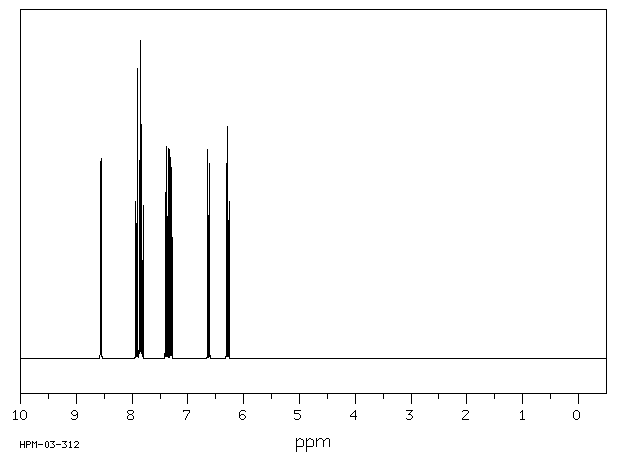1-吡啶-2-基吡啶-2-酮 | 3480-65-7
中文名称
1-吡啶-2-基吡啶-2-酮
中文别名
——
英文名称
[1,2']bipyridinyl-2-one
英文别名
2H-[1,2'-bipyridin]-2-one;1-(2-pyridyl)-2-pyridone;2H-[1,2′-bipyridin]-2-one;N-(Pyridyl-2)-pyridon-(2);1-(2'-Pyridyl)-2-pyridon;[1(2H),2'-Bipyridin]-2-one;1-pyridin-2-ylpyridin-2-one
CAS
3480-65-7
化学式
C10H8N2O
mdl
MFCD00234620
分子量
172.186
InChiKey
TTYWSMWHPYKDEW-UHFFFAOYSA-N
BEILSTEIN
——
EINECS
——
-
物化性质
-
计算性质
-
ADMET
-
安全信息
-
SDS
-
制备方法与用途
-
上下游信息
-
文献信息
-
表征谱图
-
同类化合物
-
相关功能分类
-
相关结构分类
计算性质
-
辛醇/水分配系数(LogP):1.2
-
重原子数:13
-
可旋转键数:1
-
环数:2.0
-
sp3杂化的碳原子比例:0.0
-
拓扑面积:33.2
-
氢给体数:0
-
氢受体数:2
上下游信息
-
下游产品
中文名称 英文名称 CAS号 化学式 分子量 —— 5-bromo-2H-[1,2'-bipyridin]-2-one 109822-11-9 C10H7BrN2O 251.082
反应信息
-
作为反应物:描述:参考文献:名称:de Villiers; den Hertog, Recueil des Travaux Chimiques des Pays-Bas, 1956, vol. 75, p. 1303,1307摘要:DOI:
-
作为产物:描述:2-碘吡啶 在 copper(l) iodide 、 potassium carbonate 、 (1R,2R)-(-)-N,N'-二甲基-1,2-环己二胺 作用下, 以 甲苯 为溶剂, 反应 16.0h, 以44%的产率得到1-吡啶-2-基吡啶-2-酮参考文献:名称:An improved Ullmann–Ukita–Buchwald–Li conditions for CuI-catalyzed coupling reaction of 2-pyridones with aryl halides摘要:An effective CuI-trans-N,N'-dimethylcyclohexane-1,2-diamine (DMCDA)-K2CO3-cataIyzed coupling reaction of 2-pyridones with aryl halides is described. Under our conditions, DMCDA was found to be an effective catalyst that facilitates the coupling reactions even in toluene, a common industrial solvent. In addition, 3-bromopyridine could also be coupled effectively under these conditions, indicating that the catalytic reactivity of this system is high. The reaction could be applied for polymer modification and iterative oligo-pyridone synthesis. (c) 2005 Elsevier Ltd. All rights reserved.DOI:10.1016/j.tet.2005.01.063
文献信息
-
Synthesis of Unsymmetrically Substituted Bipyridines by Palladium-Catalyzed Direct C−H Arylation of Pyridine <i>N</i>-Oxides作者:Sasa Duric、C. Christoph TzschuckeDOI:10.1021/ol200565u日期:2011.5.6Substituted bipyridines were efficiently prepared by direct coupling between pyridine N-oxides and halopyridines using a palladium catalyst. Pyridine N-oxides with electron-withdrawing substitutents gave the best yields. This method allows the convenient preparation of 2,2′-, 2,3′-, and 2,4′-bipyridines which are useful as functionalized ligands for metal complexes or as building blocks for supramolecular
-
Iridium(III)-Catalyzed Regiocontrolled Direct Amidation of Isoquinolones and Pyridones作者:Debapratim Das、Rajarshi SamantaDOI:10.1002/adsc.201701244日期:2018.1.17Iridium(III)‐catalyzed highly regiocontrolled C3/C8 amidation of isoquinolones and C6 amidation of 2‐pyridones has been successfully accomplished with various azides. The optimized method is operationally simple with a broad substrate scope. The protocol has been found to be scalable.
-
Visible-light-mediated decarboxylative alkylation of 2-pyridone derivatives <i>via</i> a C3-selective C–H functionalization作者:Worawat Niwetmarin、Rungroj Saruengkhanphasit、Chatchakorn Eurtivong、Somsak RuchirawatDOI:10.1039/d1ob01829a日期:——direct C–H functionalization approach to access C3-alkylated 2-pyridone derivatives is reported. This study utilizes N-hydroxyphthalimide (NHPI) esters of various carboxylic acids as sources of alkyl radicals by reductive cleavage under photocatalytic reaction conditions. The carbon–carbon bond formation occurred site-selectively at C3 of 2-pyridone to give the desired products in moderate to good yields
-
Rhodium-catalyzed C–H functionalization of heteroarenes using indoleBX hypervalent iodine reagents作者:Erwann Grenet、Ashis Das、Paola Caramenti、Jérôme WaserDOI:10.3762/bjoc.14.102日期:——The C-H indolation of heteroarenes was realized using the benziodoxolone hypervalent iodine reagents indoleBXs. Functionalization of the C-H bond in bipyridinones and quinoline N-oxides catalyzed by a rhodium complex allowed to incorporate indole rings into aza-heteroaromatic compounds. These new transformations displayed complete regioselectivity for the C-6 position of bipyridinones and the C-8 position
-
Rh(I)‐Catalyzed Direct C6−H Arylation of 2‐Pyridones with Aryl Carboxylic Acids作者:Haoqiang Zhao、Jianbin Xu、Xin Xu、Yixiao Pan、Zexin Yu、Lijin Xu、Qinghua Fan、Patrick J. WalshDOI:10.1002/adsc.202100596日期:2021.8.13Rh(I)-catalyzed C6-selective C−H arylation of 2-pyridones with inexpensive, readily available, safe and structurally diverse aryl carboxylic acids with the aid of a pyridine directing group is developed. This decarbonylative arylation protocol features an easy-to-handle catalytic system, and is amenable to diversely substituted 2-pyridones and aryl carboxylic acids. It allows access to a wide range
表征谱图
-
氢谱1HNMR
-
质谱MS
-
碳谱13CNMR
-
红外IR
-
拉曼Raman
-
峰位数据
-
峰位匹配
-
表征信息
同类化合物
(S)-氨氯地平-d4
(R,S)-可替宁N-氧化物-甲基-d3
(R)-(+)-2,2'',6,6''-四甲氧基-4,4''-双(二苯基膦基)-3,3''-联吡啶(1,5-环辛二烯)铑(I)四氟硼酸盐
(R)-N'-亚硝基尼古丁
(R)-DRF053二盐酸盐
(5E)-5-[(2,5-二甲基-1-吡啶-3-基-吡咯-3-基)亚甲基]-2-亚磺酰基-1,3-噻唑烷-4-酮
(5-溴-3-吡啶基)[4-(1-吡咯烷基)-1-哌啶基]甲酮
(5-氨基-6-氰基-7-甲基[1,2]噻唑并[4,5-b]吡啶-3-甲酰胺)
(2S,2'S)-(-)-[N,N'-双(2-吡啶基甲基]-2,2'-联吡咯烷双(乙腈)铁(II)六氟锑酸盐
(2S)-2-[[[9-丙-2-基-6-[(4-吡啶-2-基苯基)甲基氨基]嘌呤-2-基]氨基]丁-1-醇
(2R,2''R)-(+)-[N,N''-双(2-吡啶基甲基)]-2,2''-联吡咯烷四盐酸盐
(1'R,2'S)-尼古丁1,1'-Di-N-氧化物
黄色素-37
麦斯明-D4
麦司明
麝香吡啶
鲁非罗尼
鲁卡他胺
高氯酸N-甲基甲基吡啶正离子
高氯酸,吡啶
高奎宁酸
马来酸溴苯那敏
马来酸氯苯那敏-D6
马来酸左氨氯地平
顺式-双(异硫氰基)(2,2'-联吡啶基-4,4'-二羧基)(4,4'-二-壬基-2'-联吡啶基)钌(II)
顺式-二氯二(4-氯吡啶)铂
顺式-二(2,2'-联吡啶)二氯铬氯化物
顺式-1-(4-甲氧基苄基)-3-羟基-5-(3-吡啶)-2-吡咯烷酮
顺-双(2,2-二吡啶)二氯化钌(II) 水合物
顺-双(2,2'-二吡啶基)二氯化钌(II)二水合物
顺-二氯二(吡啶)铂(II)
顺-二(2,2'-联吡啶)二氯化钌(II)二水合物
韦德伊斯试剂
非那吡啶
非洛地平杂质C
非洛地平
非戈替尼
非布索坦杂质66
非尼拉朵
非尼拉敏
雷索替丁
阿雷地平
阿瑞洛莫
阿扎那韦中间体
阿培利司N-6
阿伐曲波帕杂质40
间硝苯地平
间-硝苯地平
镉,二碘四(4-甲基吡啶)-
锌,二溴二[4-吡啶羧硫代酸(2-吡啶基亚甲基)酰肼]-







